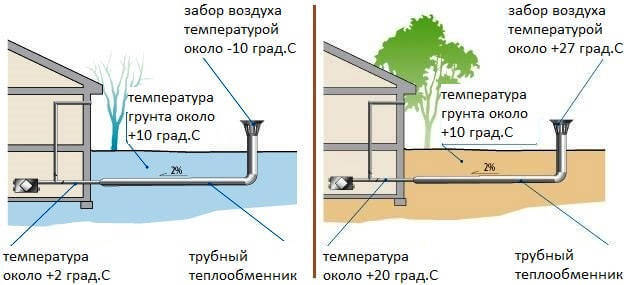In the West, the question of using inexhaustible natural resources to improve the quality of human life has been studied for a long time. And some of the developments that have gained popularity there are striking in their simplicity and effectiveness. A vivid example is natural air conditioning. This ventilation system is easily implemented in a country house at any stage of its operation. And even after its installation in the summer, you can almost freeze the air in the room. In winter, such ventilation can significantly save on heating the supply air.

The principle of operation of a natural air conditioner
The content of the article
- The principle of operation of a natural air conditioner
- Common features with the usual “stitch” and “hood”
- The highlight of the system is the laying of a soil heat exchanger
The air exchange systems that are familiar to most of us are based on the intake of fresh streams directly from the atmosphere and the discharge of exhaust waste there. The most advanced systems include a recovery module in which the incoming air is warmed by the outgoing air. But what happens if we complicate the supply ventilation a bit by increasing its length and placing the “extra” fragment underground?
The soil warms up and freezes only at a relatively shallow depth. For most regions, a mark of 1.5 meters is the maximum. Below it are layers with a stable temperature, which remains at a level of 5–7 ° C in winter and does not warm above 8–10 ° C in summer.
This property of the soil has been successfully used in the construction of cellars. And when creating a natural conditioning system.

The whole secret is that if you let the air flow through this layer of soil, then the temperature difference will tend to zero. Simply put: in winter the frosty air warms up and the hot summer cools down. And the effectiveness of such a system completely depends only on its length and competent design of the channel.
Common features with the usual “stitch” and “hood”
When it comes to design features of the ventilation system inside the house, then they simply not. All calculations of air circulation norms are carried out in accordance with sanitary standards. And the wiring of the inlet and outlet sleeves can be realized in any convenient way. But there are several important points.
- It is better to do a forced-air inflow, since a further increase in the length of the supply ducts can impede the natural flow of air.
- The hood is necessarily displayed at the level of the ridge of the roof, then you can do without its addition of fans or binding to a wind rose.
- The input of the supply shaft and the exhaust outlet are preferably located on different sides of the building.

The layout of the ventilation hoses are selected in accordance with the features of the layout of the house and the needs of its owners.
The highlight of the system is the laying of a soil heat exchanger
As already mentioned, in order for the air inlet to work in air conditioning mode, it is necessary to supplement it with a duct fan at the entrance. Power of 100-200 watts is more than enough. And here is more interesting: instead of one input channel, two should be done:
- standard, at an altitude of about 1.5 m above ground level (for ventilation during the off-season);
- underground connected to the pipe of the soil heat exchanger.
How it looks in practice can be understood by looking at the picture.

The heat exchanger itself is a pipe with a diameter of 200–250 mm laid underground below the level of soil freezing.
Do not forget about condensate. To collect it when laying the external ventilation duct, it is necessary to observe a slope of 2 degrees to the side at home, and at a distance of about a meter from the wall, you need to make a well to check the condition catchment basin.
In order for the system to effectively regulate air temperature, the total length of the tubes of the heat exchanger must be within 35–50 m. A deviation to a larger side will lead to an increase in aerodynamic drag and will require the installation of a more powerful fan, and these are extra numbers in the payment for electricity. If a shorter pipe is laid, the efficiency of the heat exchanger will decrease.
Ideally, to facilitate air circulation, it is recommended to avoid all possible bends and bends of the pipe. But not every site allows you to dig a straight trench of the required length. Therefore, as an option, you can take note of the schemes proposed below.

Right and sharp corners at bends are replaced by smooth bends or joints.
That's the trick of a natural air conditioner. The only “but” in the end - the air intake of the heat exchanger also rises to a height of 1-1.5 m above the ground. And it is sure to be covered with a protective cap with a grill - after all, you do not need those capable of damaging the rodent system with birds?


